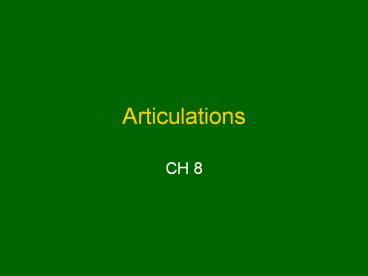Articulations - PowerPoint PPT Presentation
Title:
Articulations
Description:
Articulations – PowerPoint PPT presentation
Number of Views:63
Avg rating:3.0/5.0
Title: Articulations
1
Articulations
- CH 8
2
Outline
- Joint Cavity Components
- Joint capsule
- Articular cartilage
- Synovial membrane
- Joint accessory components
- Selected articulations
- Intervertebral articulations
- Glenohumeral joints
- Tibiofemoral joint
- Talocrural joint
3
Synovial Joint
- Space
- Yes!
- Joint cavity
- Space contents
- Synovial fluid
- Held together w/ bands of dense regular CT-
ligaments - Degree of motion
- Freely moveable
- Least stable- high motility
- Example
- Knee, elbow, fingers, shoulder
4
Synovial Joint
- fluid filled joint
- No direct bone- bone contact
- Joint cavity- persistent space between bones
- Diarthrosis- high degree of mobility
5
(No Transcript)
6
Joint Cavity Components
- Joint capsule
- Articular cartilage
- Synovial membrane
- Joint accessory components
- Accessory Capsular ligaments
- Extracapsular ligaments
- Intracapsular ligaments
- Bursae
- Menisci
- Fat pads
- Stabilizing bones muscles
7
Joint Capsule
- Dense irregular CT encloses cavity
- Function
- Adds joint stability
- Refines joint motility
- Defines joint cavity border
8
Joint Capsule
9
Joint Capsule
10
Articular Cartilage
- Structure
- Hyaline cartilage
- Function
- Reduces friction
- Shock absorption
- Modification
- Synovial fluid storage
- Porous allows synovial fluid to be released
during compression (joint motion)
11
Articular Cartilage
12
Clinical- Chondromalacia
13
Synovial Membrane
- Structure
- Membrane lining articular capsule
- Stops at articular cartilage
- Function
- Synovial fluid secretion
- Provides lubrication/ reduces friction
- Efficient motion w/out wear on bones
- Nourishes articular cartilage
- Chondrocytes acquire nutrition thru synovial
fluid - Why?
- Shock absorption
- Absorbs and distributes shock across articular
cartilage
14
Synovial Membrane
15
Joint Accessory Components
- Accessory capsular ligaments
- Extracapsular ligaments
- Intracapsular ligaments
- Articular discs menisci
- Bursae
- Fat pads
- Muscles
- Bones
16
Accessory Capsular Ligaments
- Distinct localized thickenings of articular
capsule - Work to add strength, refine motion stabilize
joints - Component of capsule
17
Capsule
Pubofemoral Ligament
18
Extracapsular ligaments
- outside capsule
- Fibers comprise the layer of CT that is on the
outside of the articular capsule
Ulnar Collateral Ligament
19
Extracapsular Ligaments
Medial Collateral Ligament (knee)
20
Intracapsular ligaments
- Fibers located within the articular capsule
21
Intracapsular Ligaments
Anterior Cruciate Ligament- Knee
22
Articular Discs Menisci
- Structure
- Fibrocartilage discs
- Function
- Change the shape of the articulating surface
- Refine joint movement- stabilize koint
- Absorb shock
- Channel distribute synovial fluid
- Location
- Articulating bones of knee
23
Menisci
24
Menisci
Provide better bone-bone fit
25
Menisci
Refine movement- stability
26
Menisci
Channel distribute synovial fluid
27
Bursae
- Fluid filled pouch
- Structure
- CT sacs filled with synovial fluid
- Lined with synovial membrane
- Connected or separated from joint cavity
- Form where ligaments or tendons rub against other
tissue - Function
- Reduce friction
- Absorb shock
- Location
- Areas of friction
28
Suprapatellar Bursa
29
Fat Pads
- Pads of fat
- Structure
- Adipose loose connective tissue proper
- Function
- Reduce friction
- Fill space
- Location
- Areas of friction
30
Infrapatellar Fat Pad
31
Stabilizing Bones Muscles
- Add stability to joint
32
Clinical Applications
- Synovial joint dislocation
- Sprain
- Strain
- Bursitis
33
Synovial Joint Dislocation
- Luxation- Full dislocation
- Subluxation- Partial dislocation
- Articulating surfaces forced out of position
- Displacement can cause joint structure damage
- Cartilage, ligaments, menisci
34
Synovial Joint Dislocation
35
Synovial Joint Dislocation
36
Double Jointed
- Weakly stabilized joints
- Permit greater range of motion
- More prone to luxation
37
Strain
- Overstretching or tearing of muscle or muscle
connective tissue - Results from joint over extension
- Repair 3-4 weeks
38
Sprain
- Overstretching or tearing of ligament or capsule
- Result from joint overextension
- Repair- 3-4 weeks
39
(No Transcript)
40
(No Transcript)
41
(No Transcript)
42
(No Transcript)
43
Bursitis
- Inflammation of the bursa
- Result from
- A direct fall or blow
- Overuse
- Infection
44
Bursitis
45
Bursitis































